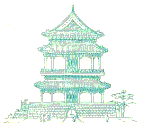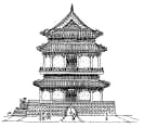|
-

REPUBLIC OF CHINA
- The opulent red and gold pavilion is a reproduction of a tradtional imperial palace - the first of its kind which has ever been erected in the Western hemisphere. Within the structure are exhibits of ancient and modern Chinese culture, and many rare and beautiful art objects: bronzes, porcelains, jades, silks and carvings in ivory, wood and stone. Taiwan's scenery, its land reform and industry are pictured. Some of the objects are in a museum.
- * Admission: free to pavilion; 25 cents to museum.
- IMPERIAL PALACE. All the components of the pavilion except its structural steel were handmade in Taiwan and are in the traditional of imperial architecture. These include painted wall and ceiling panels, roof tiles and ceremonial gate.
- DOMESTIC CULTURE. On the second floor is a reproduction of three Chinese rooms, with inlaid wood tables, embroidered cushions, musical instruments and so forth.
- ANCIENT ART. Most precious among the many richly carved objects in the third-floor museum is a 15-inch-high stone monster, with the head of a tiger and a semihuman body, perfectly preserved from the Yin Dynasty (1384-1111 B.C.). Among the bronzes are a wine cup from the same era, and a bell dating from 1122-250 B.C. Other features are a jade incense burner and a rhinoceros horn cup carved with dragons.
- THE BEGINNINGS OF WRITING. A display of calligraphy includes a tortoise shell which was inscribed 3,000 years ago with one of man's earliest written languages.
|
|
|
|

- REPUBLIC OF CHINA
Ancient bronzes, porcelain and ivory carvings are among the rare art objects shown in the replica of an emperor's palace.
The opulent red and gold building, constructed in Taiwan and shipped in pieces to the Fair, also houses modern Chinese products, a gift shop and a restaurant.
- ANCIENT CULTURE. On display in the pavilion's museum is a small stone figure with a tiger's head and a semihuman body, carved more than 3,000 years ago; a bronze wine cup of the same period; and an ancient jade incense burner.
- WRITING BEGINS. A display on the evolution of calligraphy begins with a tortoise shell inscribed a thousand years before the birth of Christ.
- TAIWAN TODAY. Displays of modern farm and industrial products illustrate recent progress on the island, which boasts one of Asia's most advanced economics.
- RESTAURANT. The cuisine includes the standard Chinese dishes.
¶ Admission: free to the pavilion; 25 cents to the museum.
|
|
|
Revised 8.14..17
|